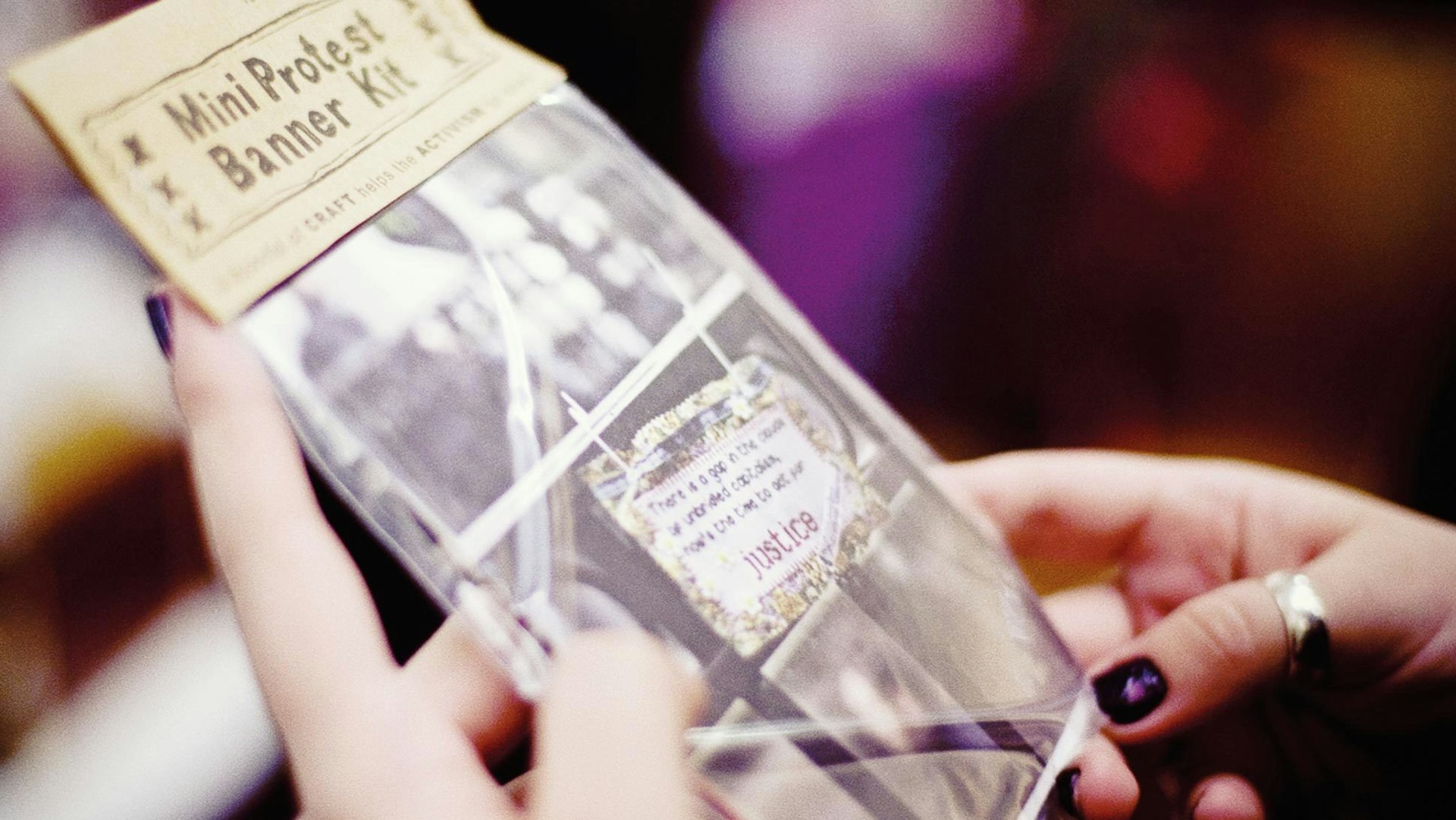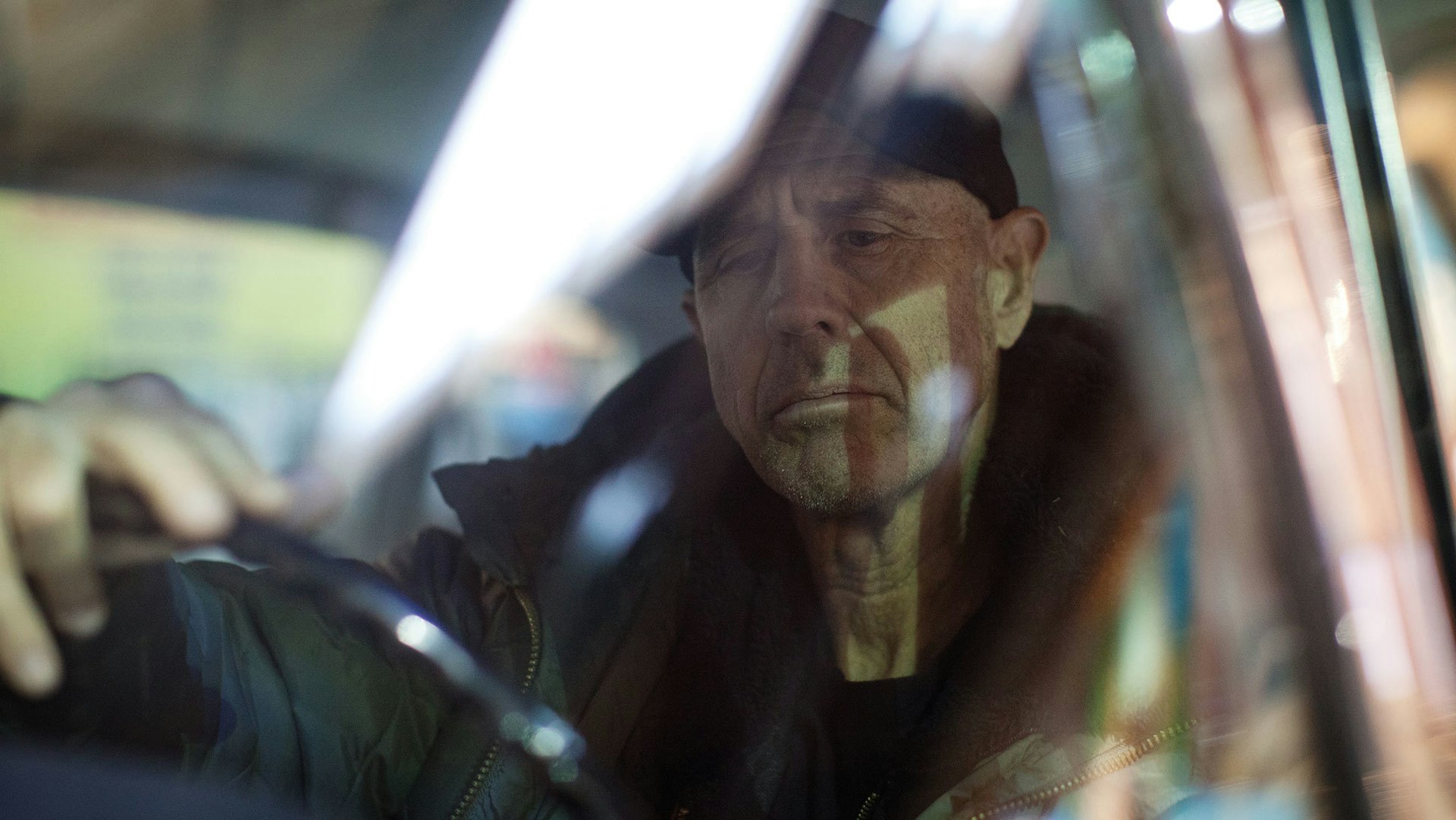
Craftivist Collective
- Text by Shannon Denny
- Photography by Liz Seabrook
We’re living in noisy times. From Tahrir Square to Wall Street and from student protests to all-out riots, the air’s become filled with fearsome chanting and beating drums. It’s a good thing – a great thing, in fact. But can a single human voice still lift above the roar?
Outside the Bank of England a gentle breeze stirs. A modest scrap of fabric undulates against the railings, creating not so much as a whisper. Here embroidery thread and cotton have joined forces, and together they silently announce their little message. ‘There is a gap in the clouds of unbridled capitalism,’ they affirm in earnest cross-stitch. ‘Now’s the time to act for justice.’ A label like one you might find in a handmade jumper reads: ‘Love from, Craftivist Collective.’
So who exactly are the Craftivist Collective? The group got its start when founder Sarah Corbett moved to London. “I joined lots of activist groups and didn’t feel like I fitted in,” she explains. “A lot of them are quite extrovert and like to dress up and chant. A lot are very black and white; you have to be vegan and ride a bike and you can’t like Vogue. And I quite like Vogue. I didn’t enjoy going on marches and shouting things. I felt quite shy and stressed out.”
Ever so quietly, she started learning about craftivism. Betsy Greer, who coined the term in 2003, defines this marriage of craft and activism as “a way of looking at life where voicing opinions through creativity makes your voice stronger, your compassion deeper and your quest for justice more infinite”. This resonated with Sarah. “So I just started this little blog,” she remembers. “And all of these quiet, creative people started going, ‘Could I join in? I’m a bit shy. Would you let me?’” It wasn’t long before Sarah’s blog, A Lonely Craftivist, naturally morphed into a community hub and, by January 2009, the Craftivist Collective was born.
There’s a steady hum in the foyer of the Royal Festival Hall, where the collective holds a Stitch-In once a month. People bring their own craftivism projects, or buy a kit they can make on the night. Together, their pieces will contribute to projects designed by core members to address all manner of issues. One co-project, in collaboration with WI group Shoreditch Sisters, sees craftivists creating embroidered vaginas for an awareness-raising campaign targeting female genital cutting.
Tonight some craftivists are at work on mini protest banners, transmitting inspiring quotes, or hard-hitting facts, one cross-stitch at a time. Others are embroidering ‘Don’t Blow It’ handkerchiefs with personal messages to their MPs. The aim, according to their website, is to remind politicians “that you are holding them to account if they go against the demands of their constituents”.
With its focus on advocacy and awareness-raising projects, Craftivism offers a softly-softly contrast to hardcore militance. The group’s slogan – ‘A spoonful of craft helps the activism go down’ – sums this up in typically upbeat language. “We’re not campaigners,” Sarah emphasises. “We make it really clear that we provoke people to discuss issues and we hope what comes out of that is a positive thing.”
The work aims to stimulate discussion not just within the walls of a Stitch-In, but out on the street, too. “If something’s small people have to find it,” says Sarah, “and they’re more likely to go up to it with an open mind and think, ‘Oh this is special, what does it say?’ And then you can hit them with something controversial.” Craftivists are encouraged to snap photos of their work in situ to include in the collective’s website and on Facebook, but it’s the casual passerby that really helps the message to go viral, by sharing photos of craftivist creations via Instagram and Twitter.
This nonviolent, subversive approach appeals to Margo Howie, who took refuge in craftivism after becoming disillusioned with the “shouting, screaming, throwing placards” of other activist circles. “I mean, great work can be done, but I was finding the same arguments and I hated a lot of the aggression. There were so many times I was just turned off by a lot of the stuff I found in protest movements. What I like about craftivism is the fact that it’s non-confrontational and it’s creative,” she says. “This is totally more my speed: slow, deliberate, forgiving, with cake and sitting down.”
The tactile nature of handcrafted items reaches audiences in a way that oral messages can’t. As many craftivists are keen to point out, the natural inclination when you’re shouted at is to inch backwards, but if you see a handmade badge on a stranger’s jacket, you’re inclined to lean forward for a closer look. And in a world where so much is temporary and virtual, a contribution that is real and lasting takes on a certain resonance.
“The output makes people think about the issues in a slightly different way from other forms of activism,” explains Erica Carroll. “The fact that you worked on it and took a long time to make it will hopefully make people think about it a little bit more. Hopefully it has a longer lasting effect; it gets to people and it gets them thinking.”
It isn’t only now, nor is it only in Britain, that craft has been used to creatively express political discontent. Sarah points to the women of Chile who, during the Pinochet dictatorship, used handcrafted tapestries called Arpilleras to draw attention to their dire situation. “The Catholic church and NGOs smuggled these Arpilleras out of the country to raise international awareness of the brutality of the Pinochet regime,” she wrote on the British Museum’s blog last year. “Not only that, the craft of these women also encouraged a powerful grassroots political movement by providing them with an opportunity to express and record their grief and emotional turmoil about the death or disappearance of their loved ones, something that the regime and the poverty they lived in didn’t allow.”
Carrie Reichardt is a core member of the Craftivist Collective, and a new project she’s designing has taken inspiration from the AIDS Memorial Quilt. “It’s the most popular piece of community art that’s ever existed,” she says of the project founded in the earliest years of the epidemic to immortalise victims it seemed history would forget. “It was nominated for the Nobel Peace Prize. But it’s a bit of sewing!” Since 1987, over 14 million people have visited the quilt at thousands of events worldwide, raising $3 million for AIDS service organisations. With 45,000 panels now in the quilt, it’s a gripping illustration of the breadth of the disease that many people in the 1980s were very keen to ignore. “That was craftivism before craftivism was given the term by Betsy Greer.”
Carrie’s cause is death penalty injustice, and she’s creating a moving – and moveable – tribute to executed Death Row inmates. With a nod to the old court tradition of the judge placing a handkerchief on his head while reading out a death sentence, the Hankie for Hope project invites supporters to stitch the name of deceased prisoners on handkerchiefs. These will be stitched together to create an ephemeral banner, a visual testimony that can forcefully but silently communicate the humanity of those condemned by the state.
She maintains that craftivism offers a form of catharsis, giving you something physical to do in the face of hugely frustrating and seemingly insurmountable obstacles. And it’s also a useful tool for creating conversation about tough topics. “For me as a person, I’m very forthright,” Carrie says. “I have very strong views. If I were to talk to people I’m likely to get into an argument. I know that if I were to set up a stall, the only people who would come up to talk to me are those people who are already on side. Or you might have someone come up and be rude to you. There isn’t much engagement.”
When she mosaicked a car as a tribute to her friend who was executed on death row, she realised her days of setting out stalls were over. “I don’t have to do anything because people come up to me and naturally ask me questions. As soon as people start to ask questions, it enables that dialogue to happen. The fact that it’s been painstakingly, labour-intensively mosaicked means that even if people don’t like the style or the image, most people can appreciate the craft,” she says. “I think it makes your voice louder; I think it enables people to hear what you’re saying.”
There’s a gentle murmur as the circle widens to make room for more craftivists arriving for the Stitch-In. “When you’re doing it with people you feel a part of some community,” says Sarah. “You feel you’re all in it together. And I really love that it’s a safe space for people of all different backgrounds. We have some really interesting discussions and debates. You don’t solve them, but it gets people having politics as part of their lifestyle.”
Tonight, much Earl Grey is consumed, the US presidential elections are discussed and new projects are plotted. All the while, these unassuming activists steadily bend wayward threads to their crafty will and weave new strands of political thought into the heart of everyday experience.
